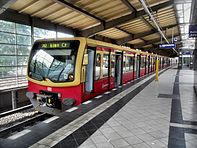Berlin
![]()
The title of this article is ambiguous. For other meanings, see Berlin (disambiguation).
Berlin (![]()
![]() [bɛɐ̯ˈliːn]) is the capital, and as a state, a parliamentary republic and a partially sovereign constituent state of the Federal Republic of Germany. With about 3.7 million inhabitants, it is the most populous municipality in Germany and the most populous city in the European Union, covering an area of 892 square kilometers. Almost 4.7 million inhabitants live in the Berlin agglomeration, and 6.2 million in the Berlin-Brandenburg capital region. The city-state consists of twelve districts. In addition to the rivers Spree and Havel, the city area is home to smaller watercourses as well as numerous lakes and forests.
[bɛɐ̯ˈliːn]) is the capital, and as a state, a parliamentary republic and a partially sovereign constituent state of the Federal Republic of Germany. With about 3.7 million inhabitants, it is the most populous municipality in Germany and the most populous city in the European Union, covering an area of 892 square kilometers. Almost 4.7 million inhabitants live in the Berlin agglomeration, and 6.2 million in the Berlin-Brandenburg capital region. The city-state consists of twelve districts. In addition to the rivers Spree and Havel, the city area is home to smaller watercourses as well as numerous lakes and forests.
First mentioned in documents in the 13th century, Berlin has been the capital of the Mark Brandenburg, Prussia and Germany throughout its history. After the end of World War II, the city was subject to the Four Power status in 1945; East Berlin functioned as the capital of the German Democratic Republic from 1949, while West Berlin was closely aligned with the old Federal Republic of Germany. With the fall of the Berlin Wall in 1989 and German reunification in 1990, the two halves of the city grew together again and Berlin regained its role as the all-German capital. Since 1999, the city has been the seat of the Federal Government, the Federal President, the German Bundestag, the Bundesrat, as well as federal ministries, numerous federal agencies and embassies.
Among the important branches of Berlin's economy are tourism, the creative and cultural industries, biotechnology and health care with medical technology and the pharmaceutical industry, information and communication technologies, construction and real estate, trade, optoelectronics, energy technology, and the trade fair and congress industry. The city is a European transportation hub for rail and air traffic. Berlin is one of the up-and-coming international centers for innovative start-ups. Berlin records high annual growth rates in the number of people in employment.
Berlin is considered a world city of culture, politics, media and science. The local universities and research institutions, local sports and museums enjoy an international reputation. The metropolis holds the UNESCO title of City of Design and is one of the most visited centers on the continent. Its architecture, festivities and nightlife are known worldwide.
Geography
→ Main article: Geography of Berlin
Location
Berlin's prominent reference point, the Red City Hall, has the geographical location: latitude 52° 31′ 7″ N, longitude 13° 24′ 30″ E. The city's area center is located about two kilometers south of it in Kreuzberg (52° 30′ 10.4″ N, 13° 24′ 15.1″ E52.502888888913.4041944444). The largest extent of the city area in the east-west direction is about 45 kilometers, in the north-south direction about 38 kilometers. The area of Berlin is almost 892 km². The city is located in the northeast of the Federal Republic of Germany and is completely surrounded by the state of Brandenburg.
The historic center is located at the narrowest and thus most convenient point of the Warsaw-Berlin glacial valley, which crosses Berlin from the southeast to the northwest and is traversed by the Spree River in an east-west direction. The northeastern part of Berlin lies on the Barnim plateau, while just under half of the city's area in the southwestern part lies on the Teltow plateau. The westernmost district, Spandau, is divided between the Berlin Urstromtal, the Brandenburg-Potsdam Havel area and the Zehdenick-Spandau Havel lowlands. Berlin's landscape was formed in the Ice Age during the most recent glaciation phase, the Vistula Ice Age. About 20,000 years ago, the area of Berlin was covered by the several 100 meters thick Scandinavian ice sheet (glacier). When the glacier melted back, the Berlin glacial valley was formed about 18,000 years ago.
See also: Berlin Settlement Star and Geology and Landscape Development in Brandenburg
Waters and elevations
Berlin has numerous flowing waters and lakes. The Spree flows into the Havel in Spandau, which flows through the west of Berlin in a north-south direction. Berlin tributaries of the Spree are the Panke, the Dahme, the Wuhle and the Erpe. The course of the Havel, actually a glacial channel, often resembles a lake landscape; the largest outcrops are formed by Lake Tegel and the Great Wannsee. The streams Tegeler Fließ and Bäke, which flow into the Havel, are located partly in Berlin. Berlin's largest lake is the Großer Müggelsee in Treptow-Köpenick.
In Berlin, 13 water protection areas covering an area of around 212 km² have been designated by water protection area ordinances. In relation to the total city area of about 890 km², this means that about a quarter of the city area is designated as water protection areas.
The highest natural elevations in Berlin are the Großer Müggelberg (115 m above sea level) in the Treptow-Köpenick district, the Arkenberge (122 m above sea level) in the Pankow district. NHN) in the district of Pankow, the Teufelsberg (120 m above sea level) in the district of Charlottenburg-Wilmersdorf and the Ahrensfelder Berge (114 m above sea level) in the Wuhletal landscape park in the district of Marzahn-Hellersdorf. The lowest point in Berlin is (28.1 m above sea level) at the Spektesee in the district of Spandau.
See also: List of surveys in Berlin and List of water protection areas in Berlin
Forests and parks
Berlin has many large parks in addition to extensive wooded areas in the west and southeast of the city (Berlin Forests). Since almost all streets are also lined with trees, Berlin is considered a particularly green city. Berlin has a total of around 440,000 street trees, including 153,000 linden trees, 82,000 maple trees, 35,000 oaks, 25,000 plane trees and 21,000 chestnut trees. The more than 2500 public green, recreational and park areas have a total area of over 5500 hectares and offer a variety of leisure and recreational opportunities. The largest facility in Berlin today designated as a park is Tempelhofer Park, which was created on the former Tempelhof Airport.
The Great Tiergarten is located in the center of the city. It is the oldest and, at 210 hectares, the second largest and most important park in Berlin and was created over the course of more than 500 years. Originally an extensive forest area at the gates of the city, used by the Prussian nobility as a hunting and riding area, this was gradually enclosed by urban development. Today it stretches from the Zoo train station to the Brandenburg Gate and borders directly on the government district. Several major roads cut through the Tiergarten, including Straße des 17. Juni as an east-west axis. They intersect at the Großer Stern, in the center of which the Victory Column has stood since 1939. The Great Tiergarten has the appearance of a natural park landscape: Characteristic are the wide lawns intersected by small watercourses and covered with groups of trees, as well as the lakes with small islands and numerous bridges and avenues. Areas such as the English Garden, the Luisen Island and the Rose Garden provide ornamental gardening accents in some places.
Along with the Tiergarten, Treptower Park in southeast Berlin is one of the city's most important parks. It was laid out from 1876 to 1882 by the first Berlin horticultural director Gustav Meyer. The wide garden landscape stretching along the Spree is one of the most popular excursion destinations for Berliners, not least because of what is now the Zenner Restaurant, built as early as 1821/1822 by Carl Ferdinand Langhans as an inn on the Spree.
A special feature among the parks is the Botanical Garden. Located in the southwest of the city, it is used not only for its scientific purpose (it belongs to the Free University of Berlin) but also as a recreational park. The predecessor institution existed since 1697 on the site of today's Kleist Park in Schöneberg. Starting in 1897, the new park was built in Dahlem and Groß-Lichterfelde. After the Greater Berlin Law of 1920 and the territorial reform of 1938, the Botanical Garden is now located in the Lichterfelde district. With an area of over 43 hectares, it is the fourth largest botanical garden in the world. It contains around 22,000 different plant species. The 25-meter high, 30-meter wide, and 60-meter long Great Tropical House is the tallest greenhouse in the world.
Other parks in Berlin include the palace gardens in Charlottenburg, Glienicke and on Peacock Island (the last two are UNESCO World Heritage Sites), the historic parks Lustgarten, Viktoriapark, Rudolph-Wilde-Park and Schillerpark, and the numerous large public gardens. The Britzer Garten was the site of the 1985 Federal Garden Show, and today's Gärten der Welt hosted the 1987 Berlin Garden Show. In 2017, the International Garden Exhibition was held there. The Mauerpark on the former death strip of the Berlin Wall, the Schöneberger Südgelände nature reserve, the Görlitzer Park and the Spreebogenpark are among Berlin's younger parks.
See also: Category:Park in Berlin
Zoos and protected areas
Berlin has several zoological institutions: the Zoological Garden together with the Aquarium and the Zoo. The Zoological Garden, opened as early as 1844 on the then city limits of Charlottenburg, is the oldest zoo in Germany and also the most species-rich in the world (around 15,000 animals in 1500 species). The much younger zoo owes its existence to the division of Germany after 1945: Because the Zoological Garden was located in the British sector of the city, the capital of the GDR lacked its own zoological institution. In 1954, therefore, a zoo was opened in Friedrichsfelde on the grounds of Schlosspark Friedrichsfelde. At 160 hectares, it is the largest landscape animal park in Europe.
In Berlin, there are 43 nature reserves (as of 2018) with a total area of 2668 hectares, which corresponds to about 3.0 percent of the state's area. In addition, there are 56 landscape conservation areas, which cover another 14 percent of the state's area. In addition, the districts of Pankow and Reinickendorf have an area share of 5.4 percent in the cross-state nature park Barnim, which covers 75,000 hectares.
See also: List of nature reserves in Berlin
Climate
The city is located in the temperate climate zone at the transition from maritime to continental climate. Since the beginning of the 20th century, the mean annual temperatures have fluctuated - with an upward trend - between 7 °C and 11 °C. The average annual temperature in Berlin-Dahlem is 9.5 °C and the average annual precipitation is 591 mm. The warmest months are July and August with an average of 19.1 and 18.2 °C, respectively, and the coldest is January with an average of 0.6 °C. The previous highest temperature in Berlin of 38.9 °C was measured at the Kaniswall station on August 7, 2015. The most precipitation falls in August with an average of 64 mm, the least in April with an average of 33 mm (all mean values from 1981 to 2010 from the German Weather Service).
With regard to wind speeds and wind direction distribution, a two-part maximum can be observed. According to this, northwest and southwest winds are observed most frequently in Berlin, which are associated with higher speeds, especially in winter, and mostly bring in maritime, well-mixed and clean sea air. The second maximum from the southeast and east is often characteristic of high-pressure weather conditions of continental air masses, which can lead to relatively hot or cold days, depending on the season.
| Berlin | ||||||||||||||||||||||||||||||||||||||||||||||||
| Climate diagram | ||||||||||||||||||||||||||||||||||||||||||||||||
| ||||||||||||||||||||||||||||||||||||||||||||||||
| Monthly average temperatures and precipitation for Berlin
Source: DWD, data: 1971-2000 | ||||||||||||||||||||||||||||||||||||||||||||||||||||||||||||||||||||||||||||||||||||||||||||||||||||||||||||||||||||||||||||||||||||||||||||||||||||||||||||||||||||||||||||||||||||||||||||||||
The small differences in altitude within the city actually result in a rather homogeneous urban climate, but the dense development in the city and district centers leads to sometimes significant temperature differences compared to large inner-city open spaces and especially to the extensive agricultural areas in the surrounding countryside. Especially on summer nights, temperature differences of up to 10 °C are measured. Overall, however, Berlin also benefits in this context from its large proportion of green space: more than 40 percent of the urban area is green; in 2012, "439,971 trees lined the streets." The large number of smaller open spaces, but especially the inner-city green spaces such as the Great Tiergarten, the Grunewald and the former Tempelhof Airport with the directly adjacent Hasenheide, create a cooling effect and are therefore also referred to as "cold islands".
City breakdown
→ Main article: Administrative division of Berlin and district of Berlin
The administration of the state of Berlin is carried out by the Senate of Berlin (the main administration) and the twelve district administrations. The central administration is responsible for the city as a whole and includes the Senate administrations, their subordinate authorities (special authorities) and non-incorporated institutions, as well as the municipal enterprises under its supervision.
Since Berlin is a unitary municipality, the boroughs do not constitute independent municipalities, but in terms of population they are comparable to larger counties in territorial states. The districts are subject to district supervision by the Senate. Each district has a district assembly (BVV). The BVV elects the district office, consisting of the district mayor and four city council members, according to party proportional representation. The district mayor is appointed by the largest parliamentary group or a larger coalition of several parliamentary groups. Despite their quasi-political election, district mayors and city councilors hold the status of elective officials. The mayors of the boroughs, chaired by the Governing Mayor, form the Council of Mayors, which advises the Senate.
The structure and tasks of the Berlin administration are derived from the General Competence Act (AZG). The structure and tasks of the Berlin district administration are defined in more detail in the District Administration Act (BezVwG). Since 1990, Berlin has been undergoing an administrative reform in partial steps.
The city-state's administrative structures and authorities are currently (as of 2016/17) rated as working too slowly and in need of modernization, both within Berlin and throughout Germany.
Berlin is divided into twelve districts according to the Berlin constitution. These are in turn subdivided into 97 districts (as of 2020), whereby the state constitution only provides for a division into districts. The local districts do not represent administrative units, but they form the basis of official location information and therefore also have administrative boundaries.
In 1920, the Greater Berlin Act consolidated eight cities as well as 59 rural communities and 27 estate districts. The new Greater Berlin originally comprised 20 districts with 94 local districts at the time, which corresponded to the previous divisions with unchanged borderlines. After the division of the city, twelve of these 20 districts were in West Berlin and eight in East Berlin.
On the occasion of the creation of new development areas on the eastern outskirts of the city, the number of districts in East Berlin - without incorporations - was increased to eleven by spin-offs between 1979 and 1986. The division in West Berlin remained unchanged (except for an exchange of territory in 1945, when the eastern part of Groß Glienicke joined Berlin in exchange for West-Staaken and became the 95th district).
In 1990, the reunified Berlin thus initially had 23 districts, the number of which was then finally reduced to twelve in 2001 through district mergers as part of a territorial reform. The number and layout of the districts have also been changed several times over the past decades.
| Key data for the districts of Berlin on December 31, 2020 | ||||
| No. | Berlin district | Inhabitants | Surface area | Inhabitants per km² |
| 01. | Center | 383.360 | 039,47 | 09.733 |
| 02. | Friedrichshain-Kreuzberg | 289.787 | 020,34 | 14.246 |
| 03. | Pankow | 410.716 | 103,07 | 03.956 |
| 04. | Charlottenburg-Wilmersdorf | 341.392 | 064,72 | 05.289 |
| 05. | Spandau | 245.527 | 091,87 | 02.656 |
| 06. | Steglitz-Zehlendorf | 308.840 | 102,56 | 03.010 |
| 07. | Tempelhof-Schöneberg | 349.539 | 053,10 | 06.622 |
| 08. | Neukölln | 327.945 | 044,93 | 07.338 |
| 09. | Treptow-Köpenick | 276.165 | 168,42 | 01.610 |
| 10. | Marzahn-Hellersdorf | 273.731 | 061,78 | 04.347 |
| 11. | Lichtenberg | 296.837 | 052,12 | 05.592 |
| 12. | Reinickendorf | 266.123 | 089,31 | 02.970 |
|
| 3.664.0880. | 891,68 | 04.088 | |
- ↑ The population figure for Berlin as a whole is taken from the population update based on the 2011 census (this is the official population figure for Berlin), while the figures for the districts are taken from the municipal population register. The total number of residents in the districts may therefore differ from the number of residents for the city as a whole.
_-_de_-_colored.svg.png)
The twelve districts of Berlin
.jpg)
Pankow City Hall (left) is the seat of the mayor of the Pankow district and the administrative authority of the Pankow district office of Berlin.
Zoological garden in the Tiergarten district, the world's most species-rich zoo and the only zoo in Germany with panda bears
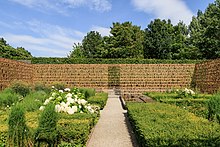
Gardens of the world
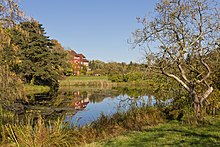
Botanical Garden in Lichterfelde
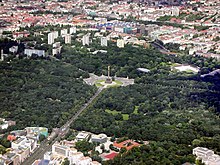
The Great Zoo (2006)
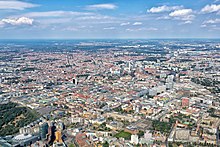
Expansion of the urban space from the center towards the north
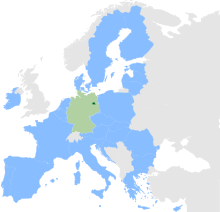
Berlin's position in Germany and the European Union
History
→ Main article: History of Berlin
Name origin and first settlements
The name Berlin is originally Slavic. It goes back to Old Polish Birlin, Berlin and means 'place in a swampy area'. It is based on Old Polish birl-, berl- 'swamp, morass', supplemented by the Slavic suffix -in indicating the location. The documentary tradition with the article ("the Berlin") speaks for an original field name, which was taken up by the settlers.
The name Kölln is probably a name transfer from Cologne on the Rhine, which goes back to Latin colonia 'planting town in a conquered country, colony'. However, a derivation from an old Polabian name *kol'no, which would be formed to kol 'stake', cannot be completely ruled out.
The name of the city is not based on the alleged founder of the city, Albrecht the Bear, nor on the Berlin heraldic animal. This is a speaking coat of arms, with which it is tried to represent the city name in German interpretation figuratively. The heraldic animal is therefore derived from the city name, not vice versa.
Margraviate and Electorate
The town of Kölln, located on the Spree Island, was first mentioned in a document in 1237. This was followed in 1244 by the mention of (Old) Berlin, which lies on the northeastern bank of the Spree. Recent archaeological finds prove that there were already pre-urban settlements on both sides of the Spree in the second half of the 12th century. In 1280, the first verifiable Mark Brandenburg Diet took place in Berlin. This points to an early top position, as can also be seen from the land book of Charles IV. (1375), when Berlin is recorded with Stendal, Prenzlau and Frankfurt/Oder as the cities with the highest tax revenues. The two cities Berlin and Kölln got a common town hall in 1307.
Berlin shared the fate of Brandenburg under the Ascanians (1157-1320), Wittelsbachers (1323-1373) and Luxemburgers (1373-1415). In 1257, the Margrave of Brandenburg was for the first time among the only electoral college entitled to elect a king. The exact rules were established in 1356 with the Golden Bull; since then Brandenburg was considered an electorate. After the German King Sigismund of Luxembourg enfeoffed Frederick I of Hohenzollern with the Mark of Brandenburg in 1415, this family ruled in Berlin as Margraves and Electors of Brandenburg until 1918, and from 1701 also as kings in and of Prussia, respectively.
From the 14th century Berlin was a member of the Hanseatic League. In 1518 Berlin formally left or was excluded from the Hanseatic League.
In 1448, residents of Berlin revolted in the "Berlin Unwill" against the new palace being built by Elector Frederick II ("Iron Tooth"). This protest was not crowned with success, however, and the city forfeited many of the political and economic freedoms it had meanwhile acquired. In 1486, Elector Johann Cicero declared Berlin the main residence city of the Brandenburg Electorate.
The Reformation was introduced in Berlin and Kölln in 1539 under Elector Joachim II, without any major confrontations. The Thirty Years' War between 1618 and 1648 had devastating consequences for Berlin: A third of the houses were damaged, and the population was cut in half. Frederick William, known as the Great Elector, took over the reins of government from his father in 1640. He began a policy of immigration and religious tolerance. From the following year, the suburbs of Friedrichswerder, Dorotheenstadt and Friedrichstadt were founded.
In 1671, 50 Jewish families from Austria were given a home in Berlin. With the Edict of Potsdam in 1685, Frederick William invited the French Huguenots to Brandenburg. Over 15,000 Frenchmen came, of whom 6000 settled in Berlin. By 1700, 20 percent of Berlin's inhabitants were French, and their cultural influence was great. Many immigrants also came from Bohemia, Poland and Salzburg. From 1658 to 1683, the twin city of Berlin-Cölln was developed into a fortress with a total of 13 bastions.
Prussia and German Empire
Berlin gained the status of the Prussian capital in 1701 with the coronation of Frederick I as King in Prussia, which became official with the edict to form the Royal Residence of Berlin by merging the cities of Berlin, Kölln, Friedrichswerder, Dorotheenstadt and Friedrichstadt on January 17, 1709. As a result, Berlin's population increased to about 55,000, and new suburbs soon sprang up, enlarging Berlin. Around 1800, the city developed into one of the centers of the German cultural landscape, which was expressed in the metropolitan civic culture known as "Berlin Classicism".
After Prussia's defeat by Napoleon's armies in 1806, King Frederick William III left Berlin for Königsberg. Authorities and wealthy families moved away from Berlin. French troops occupied the city from 1806 to 1808. Under the reformer Freiherr vom und zum Stein, the new Berlin City Code was passed in 1808, leading to the first freely elected city council. A mayor was elected to head the new administration. The swearing-in ceremony of the new city administration, called Magistrat, took place in Berlin's City Hall.
In the reforms of schools and scientific institutions, the formation of a Berlin University proposed by Wilhelm von Humboldt played a significant role. The new university (1810) quickly developed into the intellectual center of Berlin and soon became widely famous. Other reforms, such as the introduction of a trade tax, the Gewerbe-Polizeigesetz (with the abolition of guild regulations), passed under State Chancellor Karl August von Hardenberg, the civil equality of Jews, and the renewal of the army, led to a new growth spurt in Berlin. Above all, they laid the foundation for later industrial development in the city. The king returned to Berlin at the end of 1809. On May 28, 1813, death sentences were carried out for the last time in Prussia by burning at the stake in Jungfernheide.
In the following decades until around 1850, new factories settled outside the city walls, where the immigrants found employment as workers or day laborers. As a result, the number of inhabitants doubled due to immigration from the eastern parts of the country. Important companies such as Borsig, Siemens and AEG emerged and soon led to Berlin being regarded as an industrial city. This was also accompanied by the political rise of the Berlin labor movement, which developed into one of the strongest in the world.
As a result of the March Revolution, the king made numerous concessions. In 1850, a new city constitution and municipal code were adopted, according to which freedom of the press and of assembly were again abolished, a new three-class electoral system was introduced and the powers of the city councillors were severely restricted. The rights of the police chief Hinckeldey, on the other hand, were strengthened. During his term of office until 1856, he saw to the development of the city's infrastructure (above all, city sanitation, waterworks, water pipes, construction of bathing and washing facilities).
In 1861, Moabit and Wedding as well as the Tempelhof, Schöneberg, Spandau and other suburbs were incorporated. The expansion of the city was regulated by the Hobrecht Plan from 1862. Block development with an eaves height of 22 meters characterizes many Berlin neighborhoods. Rapid population growth, building speculation and poverty led to precarious living conditions in the tenements of the emerging workers' residential quarters with their multi-level, narrow backyards, typical of Berlin.
With the unification into a small German nation state by Prussian Prime Minister Otto von Bismarck on January 18, 1871, Berlin became the capital of the German Empire (until 1945). After the emergence of the Kaiserreich, the Gründerzeit followed, during which Germany rose to become a world power and Berlin became a cosmopolitan city. Berlin first became a city of millions in 1877 and exceeded the two-million-inhabitant mark for the first time in 1905. The four-decade peace ended with the start of World War I in 1914. After Germany's defeat in 1918, Kaiser Wilhelm II did not return to Berlin. He fled to the Netherlands.
Weimar Republic and Greater Berlin
After the end of the First World War, the Republic was proclaimed in Berlin on November 9, 1918. In the months following the November Revolution, there were several clashes, some of them bloody, between the government and its Freikorps and revolutionary workers. In early 1919, the January Uprising shook the city, followed two months later by a general strike. During the Berlin March battles, field guns, mortars and planes with bombs were used against the population on the orders of the Social Democratic Reichswehr Minister Gustav Noske. A total of 1200 people died in Lichtenberg from March 3 to 16.
1920 saw the bloodbath in front of the Reichstag and later the Kapp Putsch. In the second half of the year, the largest incorporation in the city's history followed with the founding of Greater Berlin, in which the previously existing Berlin merged with several surrounding towns and rural communities as well as numerous estate districts to form what is understood today as "Berlin. The city thus enlarged had a population of around four million and in the 1920s was the largest city in continental Europe and the third largest in the world after London and New York. This was accompanied by a great departure for the future. In the years that followed, the city experienced a flourishing of art, culture, science and technology and, due to the incorporation of the industrially rich suburbs in 1920, became the largest industrial city in Europe in terms of statistics. This era later became known as the "Golden Twenties," which then came to an abrupt end with the Great Depression at the end of the decade, also in Berlin.
National Socialism
After the National Socialists' "seizure of power" in 1933, Berlin initially regained importance as the capital of the Third Reich, primarily due to the centralization associated with the "Gleichschaltung" of the state governments. Adolf Hitler and Albert Speer developed architectural concepts for the transformation of the city into the "world capital Germania", which, however, were never realized.
The Nazi regime destroyed Berlin's Jewish community, which numbered around 160,000 members before 1933. After the November pogroms of 1938, thousands of Berlin Jews were deported to the nearby Sachsenhausen concentration camp. Around 50,000 of the 66,000 Jews still living in Berlin were deported from 1941 to ghettos and labor camps in Litzmannstadt, Minsk, Kaunas, Riga, Piaski or Theresienstadt. Many died there under the adverse living conditions, others were later deported to extermination camps such as Auschwitz and murdered during the Holocaust.
During World War II, Berlin was first attacked by British bombers on August 25, 1940. Allied air raids increased massively from 1943 onwards, destroying large parts of Berlin. The Battle of Berlin in 1945 resulted in further destruction. Almost half of all buildings had been destroyed, and only a quarter of all homes had remained undamaged. Of 226 bridges, only 98 were still standing.
Divided city
After the capture of the city by the Red Army and the unconditional surrender of the Wehrmacht on May 8, 1945, Berlin was divided into four sectors in July 1945 in accordance with the London Protocols - the division of all of Germany into occupation zones. The sectors of the USA, the United Kingdom, France and the Soviet Union were created. Neither the Yalta Conference nor the Potsdam Agreement envisaged a formal division into western sectors and eastern sectors (West Berlin and East Berlin). This grouping resulted in 1945/46 partly from the common interest of the Western Allies.
The Soviet Military Administration in Germany created a magistrate for Berlin as early as May 19, 1945. It consisted of a nonpartisan mayor, four deputies and 16 city councilors. For Greater Berlin, however, an overall responsibility of all four victorious powers remained. The increasing political differences between the Western Allies and the Soviet Union led to an economic blockade of West Berlin after a currency reform in the Western sectors in 1948/1949, which the Western Allies overcame with the "Berlin Airlift".
With the founding of the Federal Republic of Germany in West Germany and the German Democratic Republic (GDR) in East Germany in 1949, the Cold War also solidified in Berlin. While the Federal Republic established its seat of government in Bonn, the GDR proclaimed Berlin as its capital. Thus, since 1949, West Berlin was de facto a state of the Federal Republic with a special legal status, and East Berlin was de facto a part of the GDR. The East-West conflict culminated in the Berlin Crisis and led to the construction of the Berlin Wall by the GDR on August 13, 1961.
The east and west of the city were separated from each other ever since. The crossing was only possible at certain checkpoints, but no longer for residents of the GDR and East Berlin and until 1972 only in exceptional cases for residents of West Berlin, those who were not only in possession of the Berlin identity card.
In 1972, the Four-Power Agreement on Berlin came into force. While the Soviet Union referred to the four-power status only for West Berlin, the Western powers underlined their view of the four-power status over all of Berlin in a note to the United Nations in 1975. The problem of Berlin's disputed status is also referred to as the Berlin Question.
In the GDR, the political turn came in 1989, and the Wall was opened on November 9.
Reunited city
On October 3, 1990, the two German states were united by the accession of the GDR to the scope of the Basic Law for the Federal Republic of Germany and Berlin became the federal capital by unification treaty. In 1994, the troops of the former occupying powers finally withdrew from Berlin.
On June 20, 1991, after controversial public debate, the Bundestag decided with the Capital Resolution that the city should be the seat of the German federal government and the Bundestag. In 1994, on Richard von Weizsäcker's initiative, Bellevue Palace became the first official residence of the Federal President. Subsequently, the Office of the Federal President was built in the immediate vicinity. In 1999, the government and parliament resumed their work in Berlin. In 2001, the new Federal Chancellery was inaugurated and occupied by then Chancellor Gerhard Schröder. The majority of foreign missions in Germany moved their headquarters to Berlin in the following years.
As of January 1, 2001, the number of districts was reduced from 23 to 12 to allow for more efficient administration and planning.
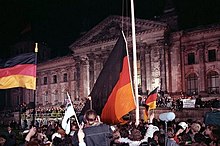
Reunification of Germany and Berlin
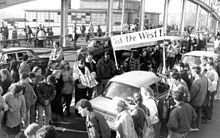
Bornholmer Strasse, 1989: After the fall of the Wall, visitors from the GDR are greeted by a welcoming palace.
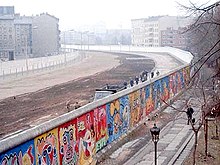
Berlin Wall, seen from Kreuzberg, 1986
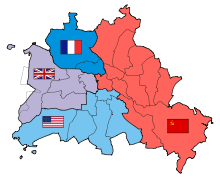
Map of the divided city

Potsdamer Square (1945)
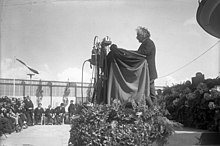
Einstein opens the 1930 Radio Exhibition

Unter den Linden, corner Friedrichstraße (around 1900)
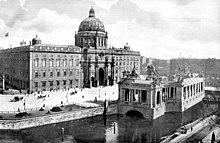
The Berlin Palace, since 1702 the main residence of the Prussian kings and from 1871 of the German emperors (picture around 1900)

Electoral Residence City of Berlin and Cologne around 1645 (copperplate engraving by Matthäus Merian)
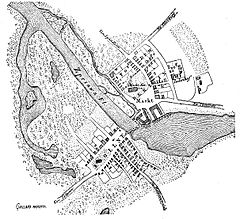
Reconstructed plan of Berlin and Kölln around 1230 (Created by K.F. von Klöden in the 19th century)
Population
→ Main article: Population of Berlin
Population development
→ Main article: Population development of Berlin
Berlin had a total of 3,664,088 inhabitants on December 31, 2020, making it the most populous city in Germany. Berlin is the most populous city in the European Union within its administrative boundaries. The Berlin agglomeration has a population of 4.7 million (December 31, 2019), and the Berlin-Brandenburg capital region, which encompasses both states, has a population of about 6.2 million.
Until the middle of the 17th century, the Berlin area was only sparsely populated; the Thirty Years' War had once again roughly halved Berlin's population. But after Elector Frederick William took over the reins of government from his father in 1640, he brought many Huguenots from France to the region, among other things. As a result, the population rose from about 6,000 around 1648 to about 57,000 in 1709. The number of inhabitants grew steadily, so that Berlin became a major city in 1747 and a city of millions in 1877.
Population development
The population increase in the Berlin area had accelerated as a result of the industrialization that began after the Prussian reforms. Only 40 percent of Berliners in the last quarter of the 19th century were born in Berlin. In 1900, of the 1.9 million Berliners, over 20 percent came from the Prussian provinces of Brandenburg, East and West Prussia 9 percent, Silesia 7 percent, Pomerania 6 percent, Posen 5 percent and Saxony 4 percent. Immigration from other regions of Germany was rather low at three to four percent and from abroad at just over 1.5 percent. The proportion of Berliners with German as their mother tongue was over 98 percent in 1895. The Greater Berlin Act of 1920 increased the population to almost four million by incorporating previously independent towns and villages. Berlin was thus the world's second-largest municipality in terms of area after Los Angeles in the 1920s and 1930s, and the third-largest city on earth in terms of population after New York City and London. The population exceeded four million in the 1920s and peaked at 4.48 million in 1942 (a theoretical figure at the time, however).
The number fell again as a result of the Second World War and has since remained constant at between three and three and a half million. Between 1957 and 1990, young men from the Federal Republic of Germany moved to West Berlin to avoid compulsory military service, because the draft laws of the Federal Republic did not apply there. The often quoted claim from 2007 that 1.7 million Berliners left the city after reunification (since 1991) and that 1.8 million people moved in, thus ensuring a large-scale population exchange, is based on a mere addition of all in-migrants and all out-migrants and exaggerates the real population fluctuation. Berlin has always had a spatial population movement that is far above average in Germany. In 2014 alone, 317,151 people moved to Berlin, while 275,259 residents moved out of the city, resulting in a positive migration balance of 41,892.
Populations
| Nationalities with main residence in Berlin on December 31, 2020 | ||
| Nationality | Nationality of | German citizens |
| Germany | 2.980.886 | 2.425.350 |
| Turkey | 0.098.437 | 0.083.969 |
| Poland | 0.055.996 | 0.057.443 |
| Syria | 0.041.418 | 0.005.657 |
| Italy | 0.032.186 | 0.008.750 |
| Bulgaria | 0.031.738 | 0.005.083 |
| Russia | 0.027.334 | 0.033.407 |
| Romania | 0.025.719 | 0.005.240 |
| United States | 0.020.993 | 0.010.313 |
| Serbia | 0.020.272 | 0.009.155 |
| France | 0.020.066 | 0.009.285 |
| Vietnam | 0.020.439 | 0.011.454 |
| United Kingdom | 0.017.165 | 0.008.713 |
| Spain | 0.015.349 | 0.005.085 |
| India | 0.015.266 | 0.001 |
| 1 Statistical values not shown | ||
Berlin has been a migration area for Germans from German-speaking countries since the end of the 17th century at the latest. The migration gain compared to the rest of Germany amounted to about 18,000 persons in 2009.
At the beginning of 2020, of the 3.77 million Berliners, 2.45 million were Germans without a migration background, around 777,000 were immigrants and 543,000 were Germans with a migration background. Thus, 1.32 million people (about 35%) have foreign roots.
In the decades after 1945, many guest workers from southern Europe and Turkey came to West Berlin and contract workers, especially from Vietnam, came to East Berlin. Since the 1980s, many ethnic Germans from Russia and, since German reunification, finally Jews from Eastern Europe, especially Ukraine and Russia, and later from Israel, made their way. Citizens from around 190 countries live in the city.
According to a 2015 study, among the large numbers of Europeans immigrating to the city, there is a particularly high proportion of young academics (24.3%), especially among French, Spanish and Italians.
Kreuzberg and Neukölln are focal points of the German-Turkish population. With about 180,000 citizens of Turkish origin, Berlin is considered to have one of the largest Turkish communities outside Turkey. In addition, around 70,000 Afro-Germans live in Berlin.
There are more than 25 groups, each with more than 10,000 people who have an immigrant background.
It is estimated that between 100,000 and 250,000 unregistered immigrants live in Berlin, mainly from Africa, Asia, the Balkans or Latin America. Due to the difficulties in defining migration background in a uniform way and recording it in surveys, the actual proportion of people with a migration background could deviate to a relevant extent from the figures mentioned.
Berlin wants to take in additional asylum seekers over and above the allocated quota and is organizing itself for this purpose with other municipalities in the "Solidarity City" network of cities.
Language
→ Main article: High German dialects and Berlin dialect
The official language in Berlin is German. Berlinish (colloquially also: Berlinerisch) is a so-called compensatory dialect, which developed in Berlin as an urban center over the centuries from various linguistic influences. Linguistically speaking, Berlinish is actually a metrolect, an urban mixture of languages that is not only of regional origin, but was created by mixing dialects of different origins. The substrate for this is Low German, which was gradually overlaid by immigration from other regions and the influence of East Central German. However, individual forms perceived as "specifically Berlinish" such as det, wat, loofen, koofen (in contrast to standard German das, was, laufen, kaufen) persisted.
Berlinish absorbed numerous words and idioms from other languages and dialects, such as French (settlement of Huguenots after the Thirty Years' War), Yiddish (Jewish refugees since the 16th, but especially in the 19th and 20th centuries) and Silesian/Polish (after the conquest of Silesia and the Polish partitions at the end of the 18th century). Berlinish is spoken in Berlin and in the Berlin environs, and it also contains only (proverbial) words or coined ironic phrases common there, the so-called "Berolinisms".
In the surroundings of Berlin as well as in the districts, which were villages without significant contact to the capital until the incorporation, originally Mark-Brandenburg dialects of East Low German were spoken. Since the end of the 19th century, Berlin, as a growing metropolis, increasingly radiated linguistically to the surrounding area, and the Berlin colloquial language displaced the local dialects or at least changed them considerably. In fact, today's Brandenburgish is a variety of the Berlin Metrolect.
Historically, Berlinish was the language of the common people; the educated classes mostly cultivated impeccable High German. Many New Berliners adopted parts of Berlinish, but its constant use was considered rather "unrefined". In the GDR, this attitude changed to some extent, so that Berlinerisch was cultivated to some extent even in educated circles. As a result, the centers of increased usage are mostly found in the former eastern districts, the old western working-class districts, and the surrounding countryside. Unchanged, the language in Berlin is influenced by waves of immigrants and language habits influenced by the media, so that the colloquial language used is constantly evolving.
Religions and worldviews
→ Main article: Religion in Berlin
The 2011 census revealed that 21.6% of Berlin's population belonged to the Protestant regional church, 9.6% to the Catholic church, 1.5% to an Orthodox church and 0.7% to a Protestant free church. Overall, 37.4% of the population described themselves as Christians, 9.0% ascribed themselves to another religion or denomination, 23.4% felt they belonged to none, and 30.2% made no statement. According to a calculation from the census figures for persons with a migration background, the proportion of Muslims in the population of Berlin in 2011 was 7.6 percent (around 249,200 persons), close to the figure published by the State Statistical Office for 2009 (around 249,000), whereas the BAMF study Muslim Life in Germany assumed around 279,800 Muslims in Berlin in 2008 (6.9 percent of around 4,055,100 Muslims in the Federal Republic of Germany).
Of the roughly 3.8 million Berliners, 13.9% were Protestant, 8.1% Catholic and 78% belonged to other denominations and religions or none at the end of 2020. In the eastern districts of the city, which were formerly part of the GDR, the percentage of people with Christian affiliation is particularly low. In the previous year 2019, 14.4% of residents were Protestant and 8.3% were Catholic. Islamic faiths accounted for 250,000 to 300,000 (7-9%) people in 2018, according to research.
Several humanist and other associations of non-religious people are represented in Berlin. For example, the Humanist Association of Germany, whose Berlin regional association had around 7,800 members in 2012, and the Humanist Academy of Germany have their headquarters in Berlin. In 1982, the school subject Humanistische Lebenskunde was introduced in the western part of Berlin, with an enrollment of nearly 62,650 students in 2017.
· 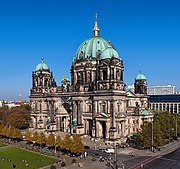
Berlin Cathedral (Protestant)
· 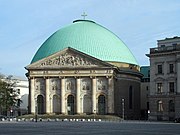
St. Hedwig's Cathedral (Roman Catholic)
· 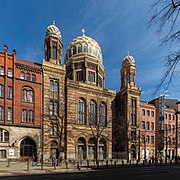
New Synagogue (Jewish)
·
Şehitlik Mosque (Muslim)
Bishop of the Evangelical Church Berlin-Brandenburg-Silesian Upper Lusatia is Christian Stäblein. Archbishop of Berlin and Metropolitan of the Berlin Church Province has been Heiner Koch since 2015.
The Independent Evangelical Lutheran Church, which is represented by eight parishes in the city area, emerged mostly from the Evangelical Lutheran Church, which was founded in 1830. These parishes belong to the Berlin-Brandenburg church district, which is led by Superintendent Peter Brückmann, Wedding.
Also based in Berlin are a Russian Orthodox and a Bulgarian Orthodox bishop, and most other Orthodox and Ancient Near Eastern national churches are also represented with parishes.
The Anglican Communion or Church ofEngland has a so-called "Chaplaincy" (parish), St. George's Anglican/Episcopal Church. The parish has its church in Westend on Preußenallee. Furthermore, there is an Old Catholic parish in Wilmersdorf, which was a guest in the Alt-Schöneberg village church, but since 2010 has its own house church near Bundesplatz. The Old Catholic and Anglican congregations are in church fellowship and celebrate joint services in the Marienkirche.
Baptists have existed in Berlin since the middle of the 19th century, and with their 36 congregations they form the largest free church in the city. Among others, there are also 29 congregations of the New Apostolic Church. There are six congregations of the Church of Jesus Christ of Latter-day Saints. The oldest Mennonite congregation in Berlin has existed since 1887.
Berlin has been the seat of the Central Council of Jews in Germany since 1999. The Jewish Community of Berlin, the largest community of the Jewish faith in Germany, has over 12,000 members. There are over eleven synagogues, several Buddhist temples, seven mosque buildings and 91 Islamic prayer rooms in the city. There have been Bahai in Berlin since 1907, and they regularly participate in the interfaith dialogue in Berlin. In addition, around 7,000 Hindus live in Berlin.
See also: List of Berlin sacral buildings
Personalities
Honorary citizens are listed in the list of Honorary Citizens of Berlin, personalities born in the city are listed in the list of Sons and Daughters of Berlin, biographies of people with a clear connection to Berlin are collected in the category Person (Berlin). Members of Berlin's state governments since 1948 can be found in the listings GoverningMayor of Berlin and List of Senators of Berlin. Various city originals are collected under Berlin Originals.

Religions in Berlin (as of 2017)
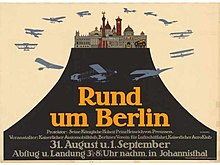
Advertising poster in Berlin (1912)

from 1871 to 2018
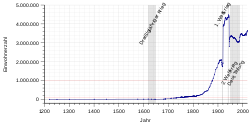
from 1220 to 2018
Politics
→ Main article: Politics in Berlin
German capital
In 1991, following reunification, the German Bundestag decided in the so-called "Capital City Decision" that Berlin, as the federal capital, should also become the seat of the Bundestag and the federal government. The Berlin/Bonn Act is a consequence of the Capital City Decision of June 20, 1991, which also designated Berlin as the seat of government.
Since 1994, the First Official Residence of the Federal President has been located in Bellevue Palace in Berlin. In 1999, most of the federal government moved from Bonn to Berlin. The Bundestag (in the Reichstag building), the Bundesrat and the federal government have since begun operating in the federal capital. In 2001, the Federal Chancellery was inaugurated and first occupied by Chancellor Gerhard Schröder. The newly constructed headquarters of the Federal Intelligence Service was occupied in November 2018.
Of the current 14 federal ministries in Germany's 17th cabinet, eight have their headquarters in Berlin. These include the Foreign Office and the Federal Ministries of Finance; Family Affairs, Senior Citizens, Women and Youth; Labor and Social Affairs; the Interior; Justice and Consumer Protection; Economic Affairs and Energy; and Transport and Digital Infrastructure. The remaining six federal ministries have their headquarters in the federal city of Bonn. All ministries, including those based in the capital, have a secondary seat in the other city.
The Federal Ministries of Education and Research; Food and Agriculture; Health; Environment, Nature Conservation, Building and Nuclear Safety; Defense; and Economic Cooperation and Development are represented in Berlin with a secondary office. Around two-thirds of the ministries' employees, some 12,600 civil servants and pay-scale employees (as of 2018), work in Berlin.
In Berlin, 158 states have their German embassy headquarters, while the 16 federal states are represented by state representations. A large number of the diplomatic missions are located in the Tiergarten district.
As the seat of government of the state with the largest economy in Europe, Berlin is one of the influential and sought-after centers of European politics. Party headquarters, trade unions, foundations, associations and corporate lobby groups are based there in order to exert their influence on decision-making processes in parliament and government. State visits and receptions at all political levels, as well as acts of state and socially significant celebrations, characterize Berlin's annual political calendar. The Federal Law Gazette, on the other hand, is still published in Bonn, and not a single federal court has its seat in Berlin.
Land Berlin
From 1808 to 1935 and from 1945 to 1948, the Prussian capital Berlin was administered by a magistrate headed by a mayor. In the period from 1935 to 1945, there was no magistrate in accordance with the German Municipal Code. From 1948 until reunification in 1990, the divided city had a magistrate in East Berlin and a senate in West Berlin.
Today's Berlin (country annex code BE) has been a Germanstate in the sense of constitutional law only since reunification. This comprises exactly the city of Berlin. Although, in addition to the Berlin state constitution of 1950, the German Basic Law also declared the state of Berlin to be a constituent state of the Federal Republic of Germany, this was ineffective under international law until then because of the reservations of the Allies. In fact, West Berlin had been part of the Federal Republic of Germany with some restrictions since 1949, while the same had no de facto effect for East Berlin, which was formally included. Article 3 of the Unification Treaty enshrined the Federal Republic's settled legal view that the Basic Law had already applied in West Berlin prior to reunification.
Legislative
According to Berlin's constitution, the state's parliament, the legislative power, is the Berlin House of Representatives. It currently includes deputies from the SPD, CDU, Left Party, Alliance 90/The Greens, AfD and FDP.
Executive
The Senate of Berlin, consisting of the Governing Mayor and ten senators, forms the state government. The Governing Mayor is also the head of the state and the city and, since 2016, has also been responsible for the Senate Administration for Science and Research. The Senate Administrations correspond to ministries in Flächenländer and are currently (as of 2017) constituted as follows: Senate Department for Finance, Senate Department for Integration, Labor and Social Affairs, Senate Department for Education, Youth and Family, Senate Department for Health, Care and Equality, Senate Department for the Interior and Sports, Senate Department for Justice, Consumer Protection and Anti-Discrimination, Senate Department for Urban Development and Housing, Senate Department for Economics, Energy and Operations, Senate Department for Culture and Europe, and the Senate Department for the Environment, Transport and Climate Protection. The Berlin Senate has been led by the SPD since 2001. Since then, it has mostly been led by the Left Party, but in some cases also by the CDU and Bündnis 90/Die Grünen.
After the election to the House of Representatives on September 18, 2011, the Senate was formed by the SPD and CDU under the leadership of Klaus Wowereit (SPD) as Governing Mayor. After Wowereit's resignation, Senate Müller I formed the new red-black government on December 11, 2014. Since 2016, the Müller II Senate has governed Berlin, the first red-red-green state government in Germany to be led by the SPD.
The state of Berlin is divided into twelve districts.
Finance
The expenditures of the State of Berlin in 2012 amounted to 22.5 billion euros. The total debt of the state of Berlin in 2013 was around 59.8 billion euros, or 57.72% of gross domestic product. For the overall budget, the state received about 3.2 billion euros from the fiscal equalization scheme of the federal states and about 2.4 billion euros in federal supplementary allocations in 2012. The European Union contributes about 850 million euros to the budget during the 2014-2020 period. In 2018, Berlin topped the list of the four recipient states by a wide margin with €4.4 billion in allocations from the Länder fiscal equalization scheme.
Coats of arms and flags
→ Main article: Coat of arms of Berlin and flag of Berlin
The Berlin coat of arms shows in the silver (white) shield a red-armored and red-tongued, upright striding black bear, the so-called Berlin bear. On the shield rests a golden five-leafed crown of leaves, whose frontal ring is laid out as a masonry with a closed gate in the middle. The origin of the bear as a heraldic animal is unclear, document or documents are missing on this. There are several theories why the city representatives chose the bear. One of them says that the Berliners thought of Albrecht the Bear, the founder of the Mark Brandenburg. Another is based on the onomatopoeic interpretation of the city's name. The bear is first seen on a seal from 1280. For several centuries, the bear had to share the seal and coat of arms images with the Brandenburg and Prussian eagle. It was not until the 20th century that the Berlin bear finally prevailed over the eagles as the city's emblem.
| Standard flagging (line of sight to state office buildings): | ||||
|
|
|
| ||
The Berlin state flag shows the Berlin bear against a white background, with a red stripe at the top and bottom of the flag. It has been flown, with minor stylistic changes, by Berlin since 1911 and first flew over the Red City Hall in 1913. Before that, Berlin flew a flag in the colors black-red-white, which was exchanged for the bear flag due to constant confusion with the later flag of the German Empire. The national symbol is the bear shield without a crown of leaves in three color versions. It is provided by the Senate Department for the Interior and Sport to enable private individuals, companies and non-governmental institutions to document their attachment to Berlin with a symbol. Berlin's districts have their own coats of arms. As a connecting element of all Berlin districts with the city of Berlin, but also among themselves, rests on the shields a three-towered wall crown, whose central tower is covered with the Berlin coat of arms (silver).
Town twinning
The state of Berlin maintains the following city partnerships:
United States ![]() Los Angeles, United States (1967)
Los Angeles, United States (1967)
France ![]() Paris, France (1987)
Paris, France (1987)
Spain ![]() Madrid, Spain (1988)
Madrid, Spain (1988)
Turkey ![]() Istanbul, Turkey (1989)
Istanbul, Turkey (1989)
Poland ![]() Warsaw, Poland (1991)
Warsaw, Poland (1991)
Russia ![]() Moscow, Russia (1991)
Moscow, Russia (1991)
Hungary ![]() Budapest, Hungary (1991)
Budapest, Hungary (1991)
Belgium ![]() Brussels, Belgium (1992)
Brussels, Belgium (1992)
Indonesia ![]() Jakarta, Indonesia (1993)
Jakarta, Indonesia (1993)
Uzbekistan ![]() Tashkent, Uzbekistan (1993)
Tashkent, Uzbekistan (1993)
Mexico Mexico City![]() , Mexico (1993)
, Mexico (1993)
China People's Republic![]() Beijing, People's Republic of China (1994)
Beijing, People's Republic of China (1994)
Japan ![]() Tokyo, Japan (1994)
Tokyo, Japan (1994)
Argentina ![]() Buenos Aires, Argentina (1994)
Buenos Aires, Argentina (1994)
Czech Republic ![]() Prague, Czech Republic (1995)
Prague, Czech Republic (1995)
Namibia ![]() Windhoek, Namibia (2000)
Windhoek, Namibia (2000)
United Kingdom ![]() London, United Kingdom (2000)
London, United Kingdom (2000)
The individual Berlin districts maintain other partnerships, often with a single district of other major cities.
Police and fire department
→ Main article: Berlin Police and Berlin Fire Department
The Berlin Police (until March 2021 "The Police Commissioner in Berlin") is the police force of the state of Berlin. The state police is divided into five local and one supra-local directorate as well as the State Criminal Police Office.
The Berlin police force employs around 23,000 staff, of whom around 16,000 are in the police enforcement service and around 3,000 in administration. The total expenditure for internal security and the police in Berlin amounts to around 1.1 billion euros per year.
The staff of the Federal Police Headquarters Berlin, located in Oberschöneweide, is subordinate to the Federal Ministry of the Interior. The staff is responsible for the states of Berlin and Brandenburg and is staffed with around 3,700 employees (as of 2017).
The Berlin Fire Department was founded in 1851, making it the first professional fire department in Germany. With its approximately 4,050 employees (as of 2016) and 34 professional fire stations, it is also the largest municipal fire department in Germany. It is supported by 58 volunteer fire departments with around 1,400 active volunteer members and, if necessary, by the Federal Agency for Technical Relief (THW).
Justice
→ Main article: Court organization in Berlin
There are 15 lower state courts and four higher state courts in the judicial district of Berlin. Of the four locations of the Higher Regional Courts in Berlin, two belong to the judicial district of the states of Berlin and Brandenburg.
The Constitutional Court of the State of Berlin has existed since 1990. In 2020, the state had eight correctional facilities.
See also: List of Courts in the State of Berlin and List of Prisons in Berlin
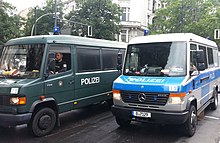
Berlin police squad car
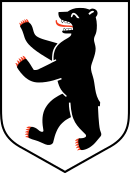
State symbol of Berlin (for free use, not to be confused with the official coat of arms)
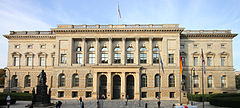
Prussian Parliament , seat of the Berlin House of Representatives
.jpg)
Rotes Rathaus , seat of the Senate of Berlin

Federal Ministry for Economic Affairs and Energy in Mitte

Bellevue Palace , seat of the German President
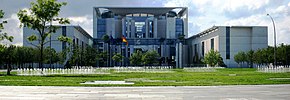
Chancellor's Office
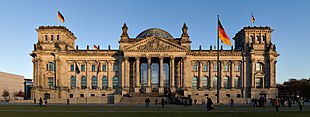
Reichstag building, seat of the German Bundestag
Economy
→ Main article: Economy of Berlin
In 2019, the nominal gross domestic product (GDP) of Berlin was €153.3 billion. In terms of nominal GDP, Berlin is the largest urban economy in Germany and the third largest within the European Union.
Between 2009 and 2019, GDP rose by an annual average of 4.5%, compared with 3.5% nationwide. In 2019, GDP per capita in the state of Berlin amounted to 41,967 euros, exceeding the national average for the first time since 1990. The number of people in employment in Berlin in the same year was around 2.064 million. This was 2.4% more than in the previous year.
According to the Social Report 2019 of the Office for Statistics, 16.5% of the population in Berlin was at risk of poverty. In contrast, 9.1% of the population lived above the wealth threshold in income wealth. In 2016, 489 income millionaires lived in Berlin. By 2019, this number had increased by more than 50% across Berlin to 749 income millionaires.
Berlin's most important economic sectors are the creative and cultural industries, tourism, biotechnology, medical technology, the pharmaceutical industry, media/information and communications technology, the construction industry, retail, transport systems technology, optics and energy technology. Around 80 % of Berlin's total economic output is generated by the service sector.
The key location factors of the Berlin-Brandenburg capital region include the renowned university and research landscape, the cultural attractiveness of the metropolis, a large number of academically trained employees, the proximity to the seat of government of the Federal Republic of Germany, the international reputation of the metropolis, access to venture capitalists, and the highly differentiated local transportation infrastructure and medical care. In various international studies and rankings, Berlin's quality of life is also rated as very above average.
One of the biggest problem areas for Berlin's economy is the birth rate, which is too low by international standards, and the high level of childlessness in large sections of the population. In the medium and long term, this could lead to an increasing shortage of skilled workers and a loss of innovative capacity. In the 2019 Future Atlas, the city of Berlin ranked 93rd out of 402 counties, municipal associations and independent cities in Germany. Berlin's greatest strength, according to the report, is the city's high level of dynamism, while its comparatively low level of value creation is its greatest weakness.
Company
Of the 30 German corporations listed on the DAX, Delivery Hero SE, Deutsche Wohnen SE and Siemens AG (shared with Munich) have a nominal headquarters in Berlin. Berlin is thus currently the city with the second most Dax companies in Germany after Munich. Among the companies with the highest turnover in the world (Fortune Global 500), Deutsche Bahn AG with its Berlin headquarters is listed at position 232 in 2020. Of the 50 MDAX companies, HelloFresh SE, Rocket Internet SE and Zalando SE are headquartered in Berlin in 2020. In the same year, two other Berlin companies were listed in the SDAX. The family-owned company with the highest turnover in Berlin is the confectionery manufacturer August Storck.
After the year 2000, Berlin recorded a very above-average number of start-ups compared to other German and European cities. New companies were established in a wide range of sectors. Both German and international young entrepreneurs realized their business models in Berlin. In 2015, 41,400 companies were created. In relation to 10,000 inhabitants, there were 29 new businesses in Berlin (national average: four). Due to the dynamic nature of newly created companies, Berlin is ranked among the ten outstanding start-up locations worldwide. In 2019, 60 percent of the invested capital in Germany was invested in Berlin-based companies. In 2019, Berlin's start-up companies received 3.5 billion euros, comparatively the most venture capital nationwide.
| The ten largest companies represented in Berlin by employees in 2020 | ||||
| Rank | Name | Headquarters | Employee | Industry |
| 01. | German railroads | Berlin | 20.770 | Transport/Logistics |
| 02. | Charité | Berlin | 17.527 | Health |
| 03. | Vivantes | Berlin | 16.136 | Health |
| 04. | Berlin transport company | Berlin | 14.589 | Traffic |
| 05. | Siemens | Berlin/Munich | 11.600 | Electrical engineering |
| 06. | Edeka | Hamburg | 10.625 | Trade |
| 07. | Daimler | Stuttgart | 010.200 | Automotive |
| 08. | German Post DHL | Berlin | 010.000 | Logistics |
| 09. | German Telekom | Berlin | 08.000 | Telecommunications |
| 10. | Zalando | Berlin | 07.300 | Digital Economy |
The strong presence of well-known companies in Berlin cannot hide the fact that the city's economy has lost a considerable amount of industrial jobs in recent decades as a result of company closures and relocations (e.g. General Electric, Philip Morris, Daimler and others). In particular, numerous manufacturing jobs were lost in the 1990s and 2000s. In the years following reunification, around three-quarters of industrial jobs were lost, although the trend began to reverse in the 2010s. The relative share of manufacturing jobs is significantly lower than in other major German cities.
See also: List of hospitals in Berlin
Tourism
Berlin is one of the most visited centers of national and international city tourism. In 2016, around 31 million overnight stays were recorded in Berlin accommodation establishments, with over 12.7 million guests. This represents an increase of about 250% compared to 2001 (11.3 million overnight stays by 4.9 million guests). The city is thus a preferred tourist destination within Europe after London and Paris.
In 2015, Berlin's lodging landscape consisted of 814 accommodations with a bed capacity of around 136,000 and an average occupancy rate of 60.5%. The average length of stay of hotel guests is 2.4 days. International guests account for about 40% of the visitor numbers. Here, visitors from the United Kingdom, Italy, the Netherlands, Spain and the United States are in the top group. The main attractions are architecture, historical sites, museums, festivities, shopping, nightlife and major events, which attract several hundred thousand visitors annually.
Due to the positive development, the tourism industry in Berlin has become an important pillar of the regional economy. In addition to the hotel and restaurant industry, the retail trade also benefits greatly from Berlin tourists.
Trade fair and congress industry
Berlin is one of the world's trade fair and congress locations with the highest attendance and turnover. In 2011, some 115,700 events were held with around 9.7 million participants. According to ICCA statistics, Berlin is ranked first among all congress cities in terms of the number of congresses with international participation in 2015.
The exhibition grounds in the Westend district of Charlottenburg-Wilmersdorf around the radio tower were opened in 1921 with an automobile exhibition, at that time in a single exhibition hall, and have an indoor exhibition area of 160,000 square meters and an outdoor area of about 100,000 square meters. It is operated by Messe Berlin, which is 99% owned by the city.
A large number of internationally relevant flagship trade shows are established at the Berlin Exhibition Grounds (Berlin ExpoCenter City) and at the Berlin ExpoCenter Airport in Brandenburg. These include the consumer electronics trade fair IFA, the tourism trade fair ITB, the aerospace show ILA Berlin Air Show, the rail transport trade fair InnoTrans, the agricultural show Grüne Woche, the food trade fair Fruit Logistica and the trade fair for eroticism & adult entertainment Venus Berlin. The European Film Market takes place during the Berlinale in the Martin-Gropius-Bau.
The congress industry, which includes international, national and local conferences, information events and business meetings of all kinds, is another branch of Berlin's economy. A large number of hotels are geared to conferences and generate an important part of their annual turnover with them.
Health Economics
With a gross value added of 10.7 billion euros in 2009, or a value added share of more than 13% of the city's overall economy, the healthcare industry is considered one of Berlin's growth engines. It includes the health and social services sector, the pharmaceutical industry, specialist, retail and wholesale trade, and medical technology. Health care and social services account for by far the largest share (66 %) of gross value added.
A total of 226,000 people, or 14% of Berlin's workforce, are employed in the healthcare industry. Of these, 79 % work in the health and social services sector and just under 6 % each in manufacturing and trade.
The Berlin-Brandenburg capital region is one of Europe's leading locations for biotechnology. Around 200 small and medium-sized biotechnology companies and more than 20 pharmaceutical companies with around 3,700 employees are active in production, research and development in Berlin-Brandenburg.
Creative Industries
Berlin is one of the leading locations for the information and creative industries in Europe. The economic sector includes the book and press market, software development, telecommunications services, the advertising market, market research, the film and broadcasting industry, the art market, the music industry, the architecture industry, the design industry and the performing arts market.
The creative and cultural industries are an important location and economic factor in Berlin and are growing continuously. In 2017, more than 41,000 mostly small and medium-sized enterprises with around 202,000 employees generated sales of €25.7 billion, accounting for more than 15% of total sales in Berlin's economy. The software/games/information and communications technology sector, the book and press market, and the film and broadcasting industry represented the largest revenue drivers.
The textile and fashion industry also has an important location in Berlin. In total, there are over 2,500 companies in Berlin with more than 22,000 employees in the fashion industry (as of 2017). Its flagship event is the Berlin Fashion Week, which takes place annually in January and July, along with a large number of accompanying fashion fairs.
In Europe, Berlin is one of the leading centers of the Internet industry. In the 2015 European city rankings, the metropolis took first place in terms of investment in the industry, ahead of London, Stockholm and Paris.
Media
→ Main article: Media in Berlin
A large number of television stations, radio stations, publishing houses, film companies, music labels, print media, advertising agencies, producers of computer games, press services, social networks and Internet media are based in Berlin.
More than 20 news agencies from around the world have offices in the city, including dpa, Thomson Reuters, AFP and ANSA. The public broadcaster rbb and the private broadcasters TV Berlin and Welt are based in Berlin. Most German national broadcasters such as Das Erste, ZDF and RTL operate studios and editorial buildings. Television producers such as Deutsche Welle have branches in the city. More than 30 radio stations with local and national coverage broadcast their programs from Berlin.
With 151 publishing houses in 2016, Berlin is one of the most important publishing locations in Europe. Axel Springer SE is one of the largest European media groups in terms of sales. The education and science publishers Walter de Gruyter, Cornelsen Verlag and the internationally active Springer Nature Group are based in the city. Important general-interest publishers include Berliner Verlag, Aufbau Verlag and Suhrkamp Verlag.
No other German-speaking city publishes more daily newspapers and their Internet portals. The most widely read national daily newspapers include Bild and Welt. The taz should also be mentioned here, probably the largest newspaper operated as a cooperative. Daily local newspapers and their Internet offshoots are the Berliner Zeitung, the Berliner Morgenpost and Der Tagesspiegel. Berlin also has the local tabloids B.Z. and Berliner Kurier and city magazines such as tip and the English-language Exberliner. Magazines produced in Berlin include Focus, Cicero and Capital.
Due to the high concentration of producers in the media and entertainment industry in the city, Berlin was one of the world's top ten media locations in terms of revenue in 2014.
Industry
The industrial sector, which includes 333 companies with around 79,300 employees, generated sales of 23.5 billion euros in 2017. The producers with the highest turnover in the manufacturing sector are manufacturers of chemical products (8.2 billion), food industry (2.3 billion), mechanical and plant engineering companies (2.1 billion) and electrotechnical industry (4.5 billion).
Founded in Berlin in 1847, Siemens operates an important site in Siemensstadt and produces gas turbines for the international market in the Mitte district. The Mercedes-Benz plant Berlin of today's Daimler AG, founded in 1902, is one of the largest industrial employers in Berlin with about 2500 employees. A wide variety of vehicles are manufactured at the plant in Marienfelde.
The BMW Berlin plant in Spandau, which opened in 1969, employs around 2,000 people. The plant produces around 700 motorcycles a day for the world market.
Stadler Rail, a Swiss manufacturer of rail vehicles, operates a plant in Pankow. In Tempelhof, the baked goods manufacturer Bahlsen and Procter & Gamble produce goods for the German and European markets. In Reinickendorf, the Berlin food manufacturer Freiberger Lebensmittel operates one of the largest pizza factories in Europe.
Trade and finance
Berlin is one of the highest-turnover locations for stationary retail in Europe. All forms of retail are represented in the city, from international retail chains operating prestigious flagship stores in Berlin to a large number of shopping centers and individual store concepts in lively neighborhoods. In 2014, there were 65 shopping centers in Berlin. Among the best-known retail operations is KaDeWe.
Berlin is Germany's highest-turnover location for real estate trading. In 2015, Berlin land and real estate worth €8 billion was traded. The annual turnover generated by real estate transactions in Berlin from 2007 to 2016 was between 6 and 17 billion euros. From 2007 to 2013, turnover in absolute terms and its share of nationwide turnover developed in parallel. This changed in the first year after Berlin applied the options under the Rent Law Amendment Act: While absolute turnover continued to rise until 2015, as in previous years, its share of nationwide turnover fell. From 2015, when the Mietpreisbremse was introduced, absolute turnover also fell.
Founded in 1695, Börse Berlin is a regional stock exchange and is headquartered in Ludwig Erhard Haus. The annual turnover of the stock exchange was about 56 billion euros in 2017. 48 credit institutions and 25 financial service providers participated in trading.
After 2000, Berlin has become an important location for e-commerce companies. Among the most successful retailers are Zalando, Home24 and kfzteile24.
Major banks based in Berlin include Deutsche Kreditbank (DKB), a wholly owned subsidiary of Bayerische Landesbank, and Berliner Sparkasse, a public-sector credit institution. The Sparkassen-Finanzgruppe, which comprises more than 600 decentralized financial services companies in Germany, is also headquartered in the city. Investitionsbank Berlin (IBB) is the central development institution of the state of Berlin. The largest private banking institutions include Berlin Hyp, Weberbank, Quirin Privatbank and N26.
Since around 2015, Berlin has been the city with the largest number of private venture capital companies in Germany. Around a quarter of all investment companies in the country are based there.
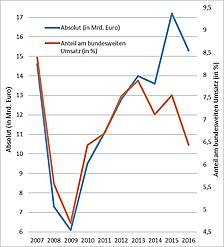
Development of sales generated in Berlin by real estate transactions in absolute terms compared with its share of Germany-wide sales.

Motorcycle from BMW Berlin plant
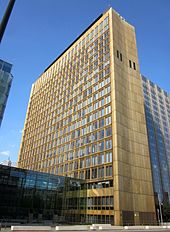
Headquarters of Axel Springer SE in Kreuzberg
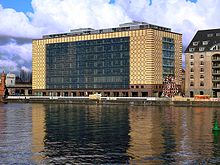
Universal Music GmbH headquarters in Friedrichshain
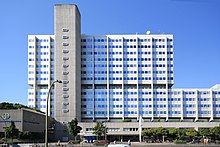
Headquarters of the Pharmaceuticals Division of Bayer AG in Wedding

Main entrance of the Berlin exhibition grounds and the radio tower in Westend
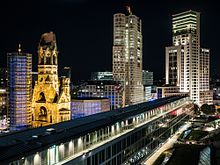
Bikini House in Charlottenburg, in the background the Kaiser Wilhelm Memorial Church and the zoo window
.jpg)
The Bahntower at Potsdamer Platz (third high-rise from left) is the headquarters of Deutsche Bahn AG.
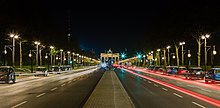
Berlin is an international service location and is considered a cosmopolitan city with a high quality of life.
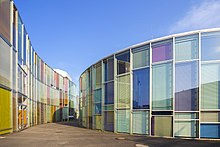
Institute at the WISTA Technology and Start-up Center in Adlershof
Infrastructure
→ Main article: Infrastructure in Berlin
Berlin streets are numbered according to two different house numbering systems. Until 1929, the circular horseshoe numbering was used, since then the zigzag orientation numbering. Since, not least because of the political upheavals, numerous Berlin streets were renamed and these changes were often used from 1929 onwards to introduce orientation numbering in the street in question, orientation numbering can also be found in many older streets.
Public transport
→ Main article: Local transport in Berlin
Berlin is an important hub for international long-distance traffic, especially for trains between Western and Eastern Europe. In 2006, the main station was opened as the central rail station and, in connection with it, the North-South mainline tunnel, the Gesundbrunnen and Südkreuz mainline stations and the Potsdamer Platz (underground), Jungfernheide and Lichterfelde Ost regional stations. In accordance with the so-called mushroom concept, this gave the railroad's regional and long-distance services an underground regional and long-distance connection in the north-south direction in addition to the light rail system laid out in the east-west direction. The changeover between the north-south mainline tunnel and the light rail takes place at the main station. Since then, trains arriving in Berlin from the south have mostly taken the new north-south route from Lichterfelde Ost via Südkreuz, Potsdamer Platz, Hauptbahnhof via the overpass to Gesundbrunnen or west via Jungfernheide to Spandau.
The city center is served by 16 S-Bahn lines (operated by S-Bahn Berlin GmbH) as well as nine subway lines, 22 streetcar lines, 150 bus lines and six ferry lines (all operated by BVG). The city center is crossed in an east-west direction by the Stadtbahn, which is laid out as a viaduct railroad and is used in parallel by S-Bahn as well as regional and long-distance traffic. It connects Ostbahnhof station with Charlottenburg station and passes through the Zoologischer Garten, Hauptbahnhof, Friedrichstrasse and Alexanderplatz stations, among others. In the north-south direction, the U9 and U6 subway lines handle most of the passenger traffic, supplemented by the underground north-south route of the S-Bahn. This S-Bahn line crosses the Stadtbahn at Friedrichstrasse station. Rail traffic is completed by the Ringbahn, which encircles the city center. All other lines touch these tracks. Accessibility of the stations is largely ensured.
The city bus network is divided into express buses (letter X), metro buses (letter M) and buses (with three-digit number). Similarly, some of the streetcar lines (two-digit number) are specially distinguished by prefixing an M as MetroTram. Night buses have an N in front of the line number as the line designation, Metro lines (both buses and streetcars) also run at night. On the nights before Saturdays, Sundays and public holidays, almost all S-Bahn and U-Bahn lines run continuously, with the S-Bahn sometimes using a different route. Long-distance bus services to German and European destinations are handled by the Central Bus Station (ZOB) at the Radio Tower. Berlin's local bus fleet is to be electrified by 2030.
In 2008, around 3100 companies were active in Berlin's cab industry, over three quarters of them with only one vehicle. Berlin had around 7600 cabs in January 2012, making it the city with the most cabs in Germany. In Berlin, there is no color approval and no registration restriction of the concessions.
See also: List of train stations in the Berlin area, List of Berlin subway stations and Long-distance bus services in Germany.
Road traffic
In 2019, 335 passenger cars were registered per 1000 inhabitants in Berlin, compared to 324 in 2012 and only 319 in 2008. Compared to other German city-states, Berlin has the lowest density of passenger cars.
The city center is surrounded from the west by a freeway semicircle (A 100 - Berliner Stadtring), which in the long term is to be completed to form a ring and represent a purely urban freeway. The so-called section BA 16 of the A 100 is under construction (status: 2021). The A 100 at the Funkturm interchange is the busiest section of highway in Germany. The A 10 freeway (E 55 - Berliner Ring) runs around Berlin.
From the A 100, several highway sections lead within the city area in the direction of the Berliner Ring. The A 111 (E 26) leads in to the northwest in the direction of Hamburg and Rostock. The A 113 to the southeast (toward Dresden and Cottbus) begins at the Neukölln interchange and leads to the Schönefelder Kreuz interchange (A 10) and connects Berlin Brandenburg Airport to the highway network. The A 115 (E 51) extends to the southwest (toward Hanover and Leipzig). Its northern, straight section is known as the AVUS.
In addition to this, in the north of the city there is the A 114 from Prenzlauer Promenade in the Pankow district to the A 10 toward Szczecin. The former A 104, which is only a few kilometers long and connects the Berlin ring road (A 100) to the south in the southwest of the city with the Steglitz district, has since been downgraded to a motorway. The A 103 (Westtangente), on which the Bundesstraße 1 runs, connects the Berlin Stadtring - from a junction further east - to the southwest with the Steglitz traffic circle in the direction of Potsdam.
The historic center of Berlin is enclosed by the inner city ring road. Furthermore, the federal roads B 1, B 2, B 5, B 96, B 96a, B 101, B 109 and B 158 run through Berlin.
Autobahn GmbH des Bundes, based in Berlin, is responsible for the planning, construction, operation, maintenance, financing and asset management of the autobahns in Berlin and Germany.
See also: Streets and squares in Berlin and Superordinate street network of Berlin
Bicycle traffic
In Berlin, there are bike lanes and bike lanes along busy streets, and some quieter streets have been designated as bike lanes. About 1.5 million trips, about 13 % of the total passenger transport volume, were made daily by bicycle as the main mode of transport in 2013. Therefore, Berlin is one of the million metropolises in Europe with a very above-average number of bicycle users.
The share of bicycle traffic in the total volume of traffic in Berlin has more than doubled since 1992. In 1992, about 7 percent of all trips were made by bicycle; in 2009, this figure was already about 15 percent. The average distance of a trip made by bicycle is 3.7 kilometers. Bicycle lanes were expanded from a total of 50 kilometers in 2004 to 191 kilometers in 2014. In 2016, the initiative Volksentscheid Fahrrad achieved a petition for a referendum. In 2018, the Berlin Mobility Act was passed, which adopted key goals of the initiative in favor of cycling.
National long-distance cycling routes such as the Berlin-Copenhagen Cycle Route, the Berlin-Usedom Cycle Route, the Berlin-Leipzig Cycle Route, the R1 European Cycle Route, the D-Net Route D11 and the D-Net Route D3 (European Route) run through Berlin. The Berlin Wall Trail runs along the former course of the Berlin Wall. Several thousand rental bicycles can be rented in the city center area by phone call or (mobile) Internet. Bike cabs operate in some areas of the city for tourist use.
Air traffic
Tegel Airport (IATA airport code: TXL) was the last airport in operation on Berlin city territory. In 2016, about 21.3 million passengers were handled there. On November 8, 2020, Tegel Airport was closed for regular flight operations.
Located just outside the city limits, Berlin Brandenburg Airport (BER) is part of the Schönefeld municipality. The formerly independent Schönefeld Airport site integrated into it was the second international airport in the Berlin-Brandenburg capital region and handled around 11.7 million passengers in 2016. Since 2006, Berlin Brandenburg Airport has been built on the Schönefeld airport area, which was expanded to the south and opened on October 31, 2020.
See also: List of Berlin airports
Inland navigation
Berlin is located in the center of the federal waterway area East. The city is served by several waterways, and inland shipping has access to three waterways to and from Berlin. The connection via the Havel, Elbe-Havel Canal and Mittelland Canal to the Elbe and North Sea or the Weser and Rhine is of the greatest importance. In addition, the Havel-Oder waterway connects Berlin with the lower Oder and the Baltic Sea. The Spree-Oder waterway, which connects the Spree with the upper Oder, has also been developed to a limited extent.
Three public port facilities can be used for handling goods: the Neukölln Port, the Spandau South Port and the West Port. The latter is located in Moabit on the northern edge of Berlin's city center and is the largest and most important of all three ports. The facilities at Westhafen and Südhafen Spandau also allow goods to be transferred between inland waterway vessels, railroads and trucks. The ports are operated by BEHALA.
See also: List of passenger shipping companies in Berlin
Bridges
Due to its exposed location on river courses and canals and its unusually large territory, Berlin has a large number of bridges and overpasses in its urban area. Officially, there are 916 bridges in Berlin. Of these, 732 connect public roads, and the remaining 184 connect paths and roads in green areas. Depending on the definition and understanding, other structures in Berlin are counted as bridges. Thus, there are 564 bridges over bodies of water of any kind and 300 elevated viaducts of the subway.
The oldest Berlin crossings of the Spree are Jungfernbrücke, Mühlendammbrücke, Rathausbrücke and Roßstraßenbrücke, with the current structures each being more recent. The longest bridge in the city, at over 930 meters, is the Rudolf Wissell Bridge, while the Oberbaum Bridge, a landmark of the Friedrichshain-Kreuzberg district, and the Glienicke Bridge, a link to Potsdam, are among Berlin's best-known bridges.
See also: List of bridges in Berlin
Water supply
Berlin's water supply is ensured by the nine waterworks Beelitzhof, Friedrichshagen, Kaulsdorf, Kladow, Spandau, Stolpe, Tegel, Tiefwerder and Wuhlheide, which are operated by Berliner Wasserbetriebe (AöR). The city's water consumption has decreased significantly since 1990. Due to lower groundwater extraction, there was a significant rise in the groundwater level in large parts of the Urstrom Valley. Particularly in the vicinity of the waterworks, this caused waterlogging damage to buildings.
In 2018, an average of 546,000 m³ of drinking water was supplied to Berlin's households, industry and commerce per day and around 624,000 m³ of wastewater was treated by the wastewater treatment plants. The wastewater reaches six large-scale treatment plants via the approximately 9500 km long sewer system.
Energy supply
During the period of German division, the power supply of West Berlin was separated from the power grid of the surrounding area and the East Berlin area from 1951. The power supply had to be provided by thermal power plants located in the western part of the city, such as the Reuter-West power plant and others. In 1993, the interrupted line connection with the surrounding area was restored. With few exceptions, all power lines in the western districts of Berlin are underground cables. The underground cable section of the 380 kV cable diagonal between the Reuter and Marzahn substations is the longest 380 kV underground cable in Germany.
|
| ||||||||||||||
| Power plants in Berlin and surrounding area, 2021 |
Until 1997, the state of Berlin held the majority of shares in Bewag, until then the city's largest municipal energy utility. In 2003, the shares were bought up in full by the Vattenfall Group. Since then, the company, together with GASAG, has been the energy supplier with the highest turnover in Berlin. With the founding of Berliner Stadtwerke in 2014, Berlin once again has its own municipal energy supplier, which is to support Berlin's goal of climate neutrality by 2050 by building its own solar and wind power plants. In 2021, the state of Berlin initiated a remunicipalization of the distribution grid operator Stromnetz Berlin GmbH.
Electricity generation in Berlin is mainly based on the use of hard coal and natural gas. The contribution of hard coal use to net electricity generation was 45 percent in 2009, well above the national average of 18 percent. Natural gas use is also above average: its share comprised 42 percent, which was also above the national average of 13 percent. Lignite contributed 9 percent of generation, well below the national average of 24 percent. The contribution of renewable energies was also below average: Their share was 3 percent, in contrast to the Germany-wide average of 17 percent.
Final energy consumption amounted to around 267.8 petajoules in 2010. Consumption was thus 7.4 percent higher than in the previous year, but it increased only slightly by 2.4 percent compared with 1990. Final energy consumption per inhabitant in the country thus amounted to 77.4 gigajoules in 2010. At 1.3 percent compared to 1990, the increase in this share is lower than the increase in total final energy consumption in the country. Broken down by sector, the "quarrying, other mining and manufacturing" sector accounted for the largest share of final energy consumption in the country, at 1.3 percent. Mining and manufacturing" has the lowest share of final energy consumption at 6.3 percent. At 24.6 percent, the transport sector requires almost four times as much energy. The largest share, however, is accounted for by the sector "Households, trade, commerce and services and other consumers" with 69.1 percent.
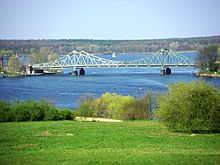
Glienicke Bridge, connecting Wannsee (right) with Potsdam (left)
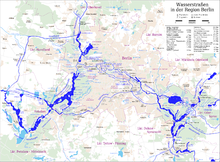
Inland waterways in Berlin
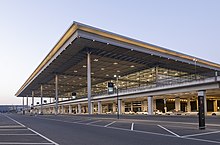
Berlin-Brandenburg Airport, Terminal 1

Bicyclist in Berlin

General map of the Berlin road and highway network.

Subway train of line U1 on Oberbaumbrücke between Friedrichshain and Kreuzberg
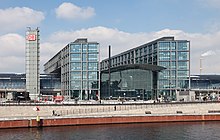
Moabit main station
Science and education
→ Main article: Education system in Berlin
Universities
Berlin looks back on more than 200 years of scientific history. 40 Nobel Prize winners have taught and worked at the city's institutes and universities. Today, Berlin is home to a large number of internationally renowned scientific and research institutions. As a university city, Berlin is one of the world's most respected centers of education.
Around 180,000 students were enrolled at a total of 42 universities and colleges in Berlin in the 2016/17 winter semester, including four art colleges. This means that the city has the largest number of students in Germany. In the global environment, Berlin is one of the world cities with very advantageous study conditions.
The four Berlin universities together have around 110,000 students. The Humboldt University of Berlin (HU), founded in the course of the Prussian reforms by Wilhelm von Humboldt and opened in 1809, currently has over 35,000 students. Freie Universität Berlin (FU) has over 37,000 students, Technische Universität Berlin (TU) about 34,000, and Universität der Künste Berlin (UdK) about 4,500. The Beuth University of Applied Sciences has over 12,000 students, the Berlin University of Applied Sciences has over 13,000 enrollees, and the Charité has about 7,200 students.
· _(9634657735).jpg)
Humboldt University Berlin in Mitte
· 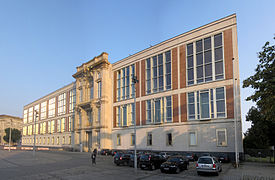
European School of Management and Technology
· 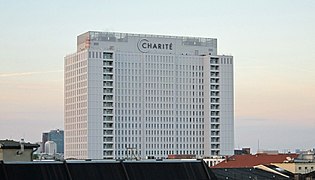
Charité
· 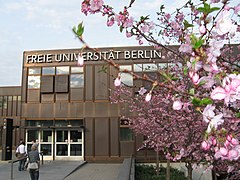
The Free University in Dahlem
· 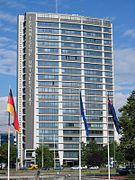
EIT Building of the TU Berlin
The medical faculties of Freie Universität and Humboldt-Universität were merged in 2003 to form Charité - Universitätsmedizin Berlin. Since then, this has been the largest medical faculty in Europe with its four locations.
As part of the Excellence Initiative, the FU Berlin and the HU zu Berlin were positively evaluated in the third funding line. Freie Universität's "International Network University" future concept, which had already received an award in 2007, was confirmed in the 2012 evaluation. Humboldt-Universität was successful with its "Education through Science" concept in 2012. This means that both universities are among the eleven German elite universities. With the announcement of the result of the Excellence Strategy 2019, FU, HU, TU, and Charité University Medicine, as institutions of the Berlin University Alliance, are together among the total of eleven German universities of excellence.
The European School of Management and Technology (ESMT) has the right to award doctorates and is one of the leading business schools in Germany and Europe. Branches of other universities include ESCP Europe Campus Berlin, Mediadesign Hochschule, Games Academy and SAE Institute.
Research
→ Main article: Universities and research institutions in Berlin
Berlin has been the strongest research region in Germany since 2012. Every year, around 1.8 billion euros in public funding is invested in science and research in Berlin.
Over 60,000 employees teach, research and work at the more than 70 non-university publicly funded research institutions. The major national research organizations Fraunhofer-Gesellschaft, Helmholtz Association, Leibniz Association and Max Planck Society are also represented with several institutes, as are various federal ministries with a total of eight research institutes. Most of the scientific institutions are concentrated at the sites in Buch, Charlottenburg, Dahlem, Mitte and at the science and business location Adlershof. The State of Berlin is a "Corporate Sponsoring Member" of the Max Planck Society.
The International Mathematical Union, a mathematics world association that awards the globally renowned Fields Medal every four years, is based in Berlin.
Childcare and school system
In Berlin, from the age of one, every child has a legal right to daily half-day care of up to seven hours in a daycare center or in daycare for children. Daycare places have been free of charge since August 2018. About 46 percent of the under-threes in the city and about 95 percent of the 3- to 6-year-olds were cared for in daycare centers in 2016.
Berlin has a six-year elementary school system and, since 2010, a connecting two-tier secondary school system with integrated secondary schools and grammar schools. In the 2015/16 school year, there were nearly 340,000 students at 799 general education schools in Berlin, including 138 private schools. The state has 433 elementary schools and 165 integrated secondary schools, as well as 113 grammar schools, 10 Waldorf schools and 77 special needs schools.
In January/February 2004, the House of Representatives passed a new school law with the following major reforms. A reduction in the length of schooling up to the Abitur (general university entrance qualification) from thirteen to twelve years, the Mittlerer Schulabschluss taking place in the tenth grade, and a written examination to obtain the Realschulabschluss. This examination is also taken at the Gymnasien. The Central Abitur was introduced in German, mathematics and foreign languages. At thirteen high schools with a "fast-track" program, it is possible to take the Abitur one year earlier, i.e. after eleven years since the new school law came into force.
A total of 38,633 apprentices were undergoing vocational training in 2016, including 9,355 in the skilled trades. The most popular apprenticeship occupations in Berlin that year were office management assistant (2,572) followed by retail sales assistant (2,251). 18,273 trainees earned a vocational qualification.
See also: School Structure Reform in Berlin and Category:School in Berlin
Libraries
→ Main article: List of libraries in Berlin
The Staatsbibliothek zu Berlin, with a collection of 25 million works, is the largest academic universal library in the German-speaking world and one of the most important in the European Union.
Other large academic libraries are the university library of Freie Universität, the university library of Humboldt-Universität and the central library of TU and UdK. The Central and State Library of Berlin is the central public library of the state of Berlin.
The Berlin Art Library of the National Museums in Berlin with its holdings (approx. 400,000 volumes on European art history and around 1400 international journals) is one of the most important specialized art libraries in Germany.
There is at least one district library in every Berlin district, with additional branches located in the local districts. In 2014, Berlin's libraries had more than 9 million visitors who borrowed around 23 million items.

Supercomputer at the Konrad Zuse Institute

Freiherr-vom-Stein High School in Spandau

State Library Unter den Linden
See also
![]()
Portal: Berlin - Overview of Wikipedia content on the topic Berlin
- List of the largest cities in the world (historical)
- List of the largest metropolitan regions in the world
- List of the largest cities in Europe
- List of the largest cities in the European Union
- List of million cities
- List of major cities in Germany
- Berlin statistics
Questions and Answers
Q: What is the population of Berlin?
A: The population of Berlin is around 3.7 million people in 2020.
Q: What countries are represented in Berlin?
A: Residents of Berlin come from about 190 different countries.
Q: Where is Berlin located?
A: Berlin is located in the eastern part of Germany in Central Europe and it is surrounded by many forests and lakes.
Q: What famous buildings can be found in Berlin?
A: Famous buildings and monuments that can be found in Berlin include the Siegessäule, the Brandenburger Tor, the Reichstag and Unter den Linden boulevard.
Q: How did World War Two affect Berlin?
A: During World War Two, bombs destroyed many buildings in the city. Afterward, the city was split into West and East parts with a wall built to divide them until 1989 when it was taken down.
Q: What makes Berlin an important city today?
A: Today, Berlin is a world city for culture, start ups, politics, media and science with many technology companies contributing to its economy. It's also an important place for tourism and business due to its connections via planes and trains.
Search within the encyclopedia
_841-723-(118).jpg)

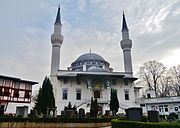
.svg.png)
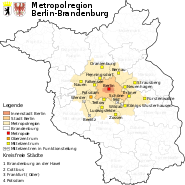

.png)

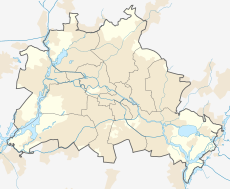
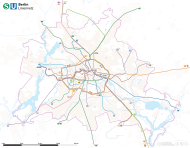
.jpg)
